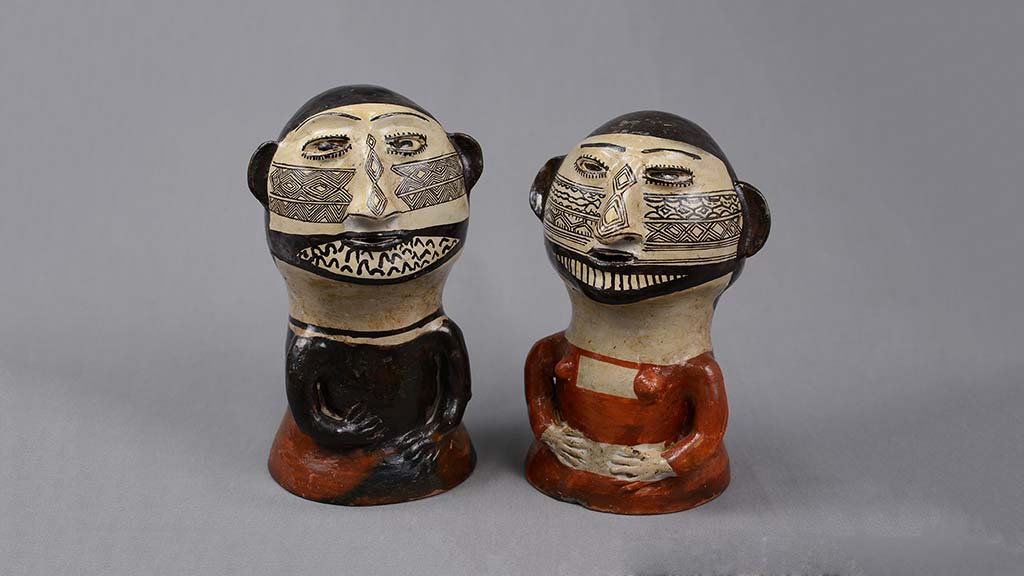
Featured Artifact: Festival Drinking Vessel: Unaimanda, Two-Headed Effigy 1997.15.0132
- Post Date: 6/22/2018
- Author: Cora Low, Registration Student
- Reading Time: 5 minute read
This ceremonial drinking vessel created by indigenous Quichuan artist Alicia Canelos of Sarayacu-Sarayaquilu, Ecuador is used to serve the popular beverage asua, a fermented drink produced from yuca (manioc). Pottery is an important marker of cultural identity in both production techniques and designs for Ecuadorian indigenous people. It is an integral part of festival ceremonies, demarks gender roles, and reflects their cosmological and mythological ideologies. On this vessel titled Unaimanda, which means "the duality in the Mythic Time-Space," we can see drawings of human faces with decorative paint on both sides, as well as various animals such as the bird and iguana. It represents the many dimensions of Mythic Time-Space and symbolizes the ancient concepts of duality: sun and moon, day and night, order and chaos, forest spirit and human spirit.
Quichuan cosmology and the Mythic Time-Space
In the Quichuan cosmology, Unai is the Mythic Time-Space which refers to that which came before the Beginnings. In this time-space, all celestial bodies, trees, animals, rocks, spirits, and souls possessed the sentient qualities that we today regard as human. Time and space were not considered as separate dimensions, and time was not conceptualized linearly. After the Mythic Time-Space, came the time of the ancestors. The concept of duality was born through the telling of a myth. According to the myth, Jilucu, a potoo bird, had a lover who would only come to her at night. She wanted to know who he was, and so one night she painted his face with Genipa americana juice, called huiduj. The next morning the black color from the juice emerged, showing up as beautifully painted pattern on her brother (the moon) Quilla’s face, and she knew with horror that she had committed incest. Her children, the stars as humans, will possess a duality of both male and female soul, of both potoo bird and moon soul. The concept of continuity and duality is thus very important in the Quichuan culture.
-
 The drinking vessel viewed from above. 1997.15.0132
The drinking vessel viewed from above. 1997.15.0132
Women and Pottery
In Canelos Quichua culture, Mama refers to any women who is wife of the household. She plays both the roles of asua mama, chicha producer, and asua churana mama, producer of the chicha pots. The pottery making skills are passed down through females in the family. A woman’s skills reflect her mastery of knowledge that allows her to control the symbols of the universe. Quichua women have continued to make fine pottery such as tinaja (storage jars) and mucahua (drinking bowls) for everyday use, as well special vessels and bowls for ceremonial and festival use. Potteries are made by traditional method of hand coiling, shaping, decorating, and firing. The clay is obtained from clay deposits in river banks and brooks, or by penetrating an underground deposit in the forest. We often see fine line drawings painted onto the surface of the pottery using red, black and white clay slips, applied with brushes made of human hair. These colorful potteries are then coated with a tree resin called shiquillu.
-
 The drinking vessel viewed from the open side of one of the spouts. 1997.15.0132
The drinking vessel viewed from the open side of one of the spouts. 1997.15.0132
-
 The drinking vessel viewed from the side. 1997.15.0132
The drinking vessel viewed from the side. 1997.15.0132
-
- Share:
- Subscribe to Newletter
- Giving
